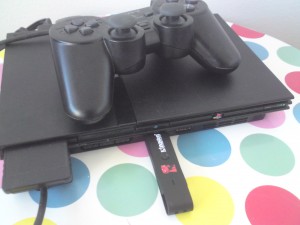Reuse is the better form of recycling, and the machines that we all increasingly use are fabulous concoctions of various plastics, metals and ceramic compounds. It’s simply shortsighted to treat them as throwaway items. With this in mind, and lacking a computer I can use at gigs with a GPU for a while now, I thought I’d postpone the inevitable cost by doing a little obsolete tech archeology.
I think homebrew and it’s associated arts – as a creative subversion (rather than a route to piracy) is increasingly relevant, so I’m going to try and log my notes here. The information out there can be a bit challenging to understand, but I’d also like to show that it’s not that much of a dark art (compared to official development of, for example android which I’ve been exploring lately). I must admit an advantage with PS2, as some time ago I was doing this “the proper way” for things like this, so perhaps some useful information can leak out of long dead NDA’s too.

The first problem to overcome with homebrew is how to get the machine to run code it’s not supposed to run. You need special hardware to burn PS2 bootable disks, and the hardcore approach to getting around that is known as the swap trick. You block the various sensors that detect if a disk is present, make a copy of a game on a CDR, replacing the code with your own. Boot using the original, then find a place in the game where the software isn’t paying attention and carefully switch it with the CDR. Once you can run “unofficial code”, you can make use of one of the various discovered exploits to (for example) make a bootable memory card to launch your own software from then on. A simpler approach is to give your memory card to someone who has already done this and get them to do it for you.
I didn’t know anyone who had done this, and I am also not that hardcore, so I spent a little bit of cash on a bootable CD designed for this purpose (which is legal to produce, because of homebrew). Along with the CD you get a variety of small shaped pieces of plastic for circumventing the drive opening detectors. These are only really needed for piracy though AFAICT, as you can boot into homebrew on a normal USB stick, so I haven’t needed to bother with them.
Leave a Reply